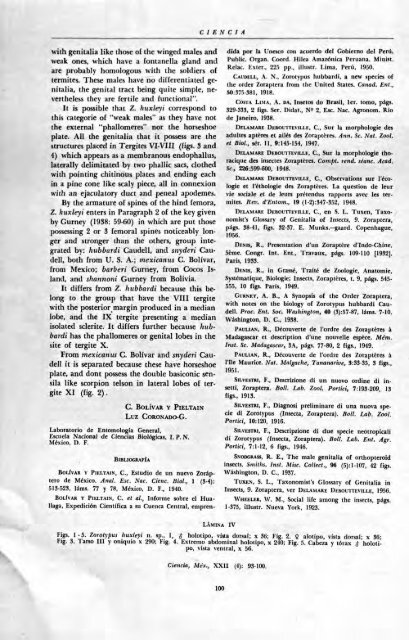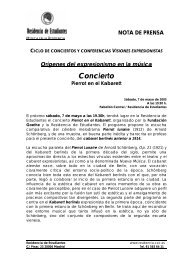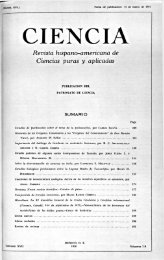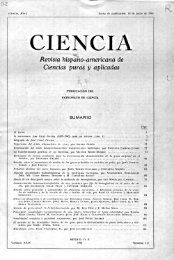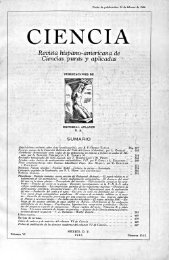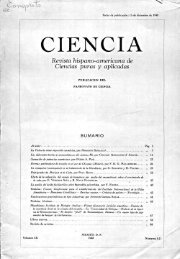C I E N C I A - Consejo Superior de Investigaciones Científicas
C I E N C I A - Consejo Superior de Investigaciones Científicas
C I E N C I A - Consejo Superior de Investigaciones Científicas
You also want an ePaper? Increase the reach of your titles
YUMPU automatically turns print PDFs into web optimized ePapers that Google loves.
CIENCIA<br />
with genitalia like those of the winged males and<br />
weak ones, which have a fontanella gland and<br />
are probably homologous with the soldiers of<br />
termites. These males have no differentiated ge<br />
nitalia, the genital tract being quite simple, ne<br />
vertheless they are fertile and functional".<br />
It is possible that Z. huxleyi correspond to<br />
this categorie of "weak males" as they have not<br />
the external "phallomeres" nor the horseshoe<br />
plate. All the genitalia that it possess are the<br />
structures placed in Tergites VI-VIII (figs. 3 and<br />
4) which appears as a membranous endophallus,<br />
laterally <strong>de</strong>limitated by two phallic sacs, clothed<br />
with pointing chitinous plates and ending each<br />
in a pine cone like scaly piece, all in connexion<br />
with an ejaculatory duct and peneal apo<strong>de</strong>mes.<br />
By the armature of spines of the hind femora,<br />
Z. huxleyi enters in Paragraph 2 of the key given<br />
by Gurney (1938: 59-60) in which are put those<br />
|M>ssessing 2 or 3 femoral spines noticeably lon<br />
ger and stronger than the others, group inte<br />
grated by: hubbardi Cau<strong>de</strong>ll, and sny<strong>de</strong>ri Cau-<br />
<strong>de</strong>ll, both from U. S. A.; mexicanas C. Bolivar,<br />
from Mexico; barberi Gurney, from Cocos Is<br />
land, and shannoni Gurney from Bolivia.<br />
It differs from Z. hubbardi because this be<br />
long to the group that have the VIII tergite<br />
with the posterior margin produced in a median<br />
lobe, and the IX tergite presenting a median<br />
isolated sclerite. It differs further because hub<br />
bardi has the phallomeres or genital lobes in the<br />
site of tergite X.<br />
From mexicanus C. Bolivar and sny<strong>de</strong>ri Cau<br />
<strong>de</strong>ll it is separated because these have horseshoe<br />
plate, and dont possess the double basiconic sen-<br />
sila like scorpion telson in lateral lobes of ter<br />
gite XI (fig. 2).<br />
C. BOLÍVAR Y PIELTAIN<br />
Luz CORONADO-G.<br />
Laboratorio <strong>de</strong> Entomología General,<br />
Escuela Nacional <strong>de</strong> Ciencias Biológicas, I. P. N.<br />
México, D. F.<br />
BIBLIOGRAFÍA<br />
BOLÍVAR Y PIELTAIN, C, Estudio <strong>de</strong> un nuevo Zoráptero<br />
<strong>de</strong> México. Anal. Esc. Nac. Cieñe. Biol., 1 (3-4):<br />
513-523, láms. 77 y 78, México, D. F.. 1940.<br />
BOLÍVAR Y PIELTAIN, C. el al., Informe sobre el Huallaga,<br />
Expedición Científica a su Cuenca Central, empren<br />
LÁMINA IV<br />
dida por la Unesco con acuerdo <strong>de</strong>l Gobierno <strong>de</strong>l Peni.<br />
Public. Organ. Coord. Iiilea Amazónica Peruana. Minist.<br />
Relac. Exter.. 225 pp.. illustr. Lima, Perú. 1950.<br />
< N : i. 111. A. N, Zorotypus hubbardi, a new species of<br />
the or<strong>de</strong>r Zorapiera from the United Stales. Canad. Eni.,<br />
50:375-381, 1918.<br />
COSTA LIMA, A. DA, Insetos do Brasil, 1er. tomo, págs.<br />
329-333. 2 figs. Ser. Didal.. N» 2. Esc. Nac. Agronom. Rio<br />
<strong>de</strong> Janeiro. 1938.<br />
Hi LA vi ARI DEBOITIIVILLF, C. Sur la morphologie <strong>de</strong>s<br />
adultes aptères et ailés <strong>de</strong>s Zoraptères. Ann. Sc. Nal. Zool.<br />
el Biol., sér. 11. 9:145 154. 1947.<br />
DELAMARE Hi uni i il ni i i C, Sur la morphologie ihn<br />
im i i j 111' <strong>de</strong>s insectes Zoraptères. Compi, rend, séanc. Acad.<br />
Sc., 226:599-600, 1948.<br />
Ili mini DFBOUTTEVILLF, C., Observations sur l'écologie<br />
et l'éthologic <strong>de</strong>s Zoraptères. I ,i question <strong>de</strong> leur<br />
vie sociale cl <strong>de</strong> leurs prétendus rapixirls avec les termites.<br />
Rn: d'Enlom., 19 (l-2):S47-352. 1948.<br />
DF.LAMARF DFBOL'TTFVILLF, C, en S. L. Tuxen, Taxonomist's<br />
Glossary of Genitalia of Insects, 9. Zorapiera,<br />
págs. 38-41, figs. 32-37. E. Münks.—gaard. Copenhague,<br />
1956.<br />
DENIS, R., Presentation d'un Zoraptère d'lndo-Chine.<br />
".«-in«-. Congr. Int. Em., Travaux, págs. 109-110 [1932].<br />
Paris, 1933.<br />
DENIS, R., in Grasse, 'Frailé


